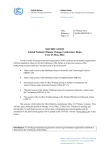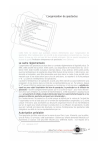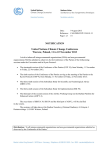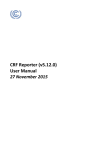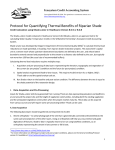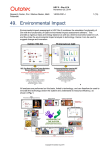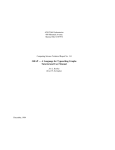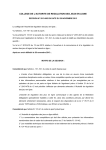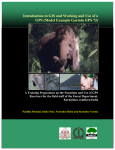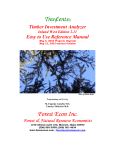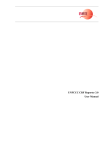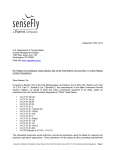Download fccc/sbsta/2007/inf.2
Transcript
UNITED NATIONS Distr. GENERAL FCCC/SBSTA/2007/INF.2 9 October 2007 ENGLISH ONLY SUBSIDIARY BODY FOR SCIENTIFIC AND TECHNOLOGICAL ADVICE Twenty-seventh session Bali, 3–11 December 2007 Item 9 (d) of the provisional agenda Methodological issues under the Kyoto Protocol Good practice guidance for land use, land-use change and forestry activities under Article 3, paragraphs 3 and 4, of the Kyoto Protocol Synthesis of views on the tables of the common reporting format for reporting estimates of greenhouse gas emissions and removals from land use, land-use change and forestry activities under Article 3, paragraphs 3 and 4, of the Kyoto Protocol in accordance with decision 15/CP.10 and relevant experiences, submitted by Parties Note by the secretariat Summary This synthesis of views includes proposals by Parties on how to improve the structure and content of the common reporting format tables for reporting estimates of greenhouse gas emissions and removals from land-use, land use change and forestry activities under Article 3, paragraphs 3 and 4, on the Kyoto Protocol. The note, based on submissions by Parties (FCCC/SBSTA/2007/MISC.28), has been prepared to facilitate the consideration and possible revision of the tables during the twenty-seventh session of the Subsidiary Body for Scientific and Technological Advice. GE.07-63913 FCCC/SBSTA/2007/INF.2 Page 2 CONTENTS Paragraphs I. II. Page INTRODUCTION ............................................................................... 1–6 3 A. Mandate .................................................................................. 1–2 3 B. Scope of the note .................................................................... 3 3 C. Possible action by the Subsidiary Body for Scientific and Technological Advice............................................................. 4–6 3 SYNTHESIS OF THE VIEWS EXPRESSED BY PARTIES ON THE USE OF THE TABLES OF THE COMMON REPORTING FORMAT FOR LAND USE, LAND-USE CHANGE AND FORESTRY ACTIVITIES UNDER ARTICLE 3, PARAGRAPHS 3 AND 4, OF THE KYOTO PROTOCOL.......................................... 7–15 3 A. Background............................................................................. 7 3 B. Approach ................................................................................ 8–9 4 C. Synthesis of views of Parties relating to the structure and/or content of tables ..................................................................... 10–15 4 D. Synthesis of the views expressed by Parties on the use of the provisional electronic spreadsheets of the common reporting format for reporting land use, land-use change and forestry activities under Article 3, paragraphs 3 and 4, of the Kyoto Protocol and suggested technical improvements......... 11 FCCC/SBSTA/2007/INF.2 Page 3 I. Introduction A. Mandate 1. The Conference of the Parties (COP), by its decision 15/CP.10, encouraged Parties included in Annex I to the Convention that have ratified the Kyoto Protocol to submit, on a voluntary basis, with their submission due on 15 April 2007: estimates of greenhouse gas (GHG) emissions by sources and removals by sinks resulting from activities under Article 3, paragraphs 3 and 4, of the Kyoto Protocol, using the tables of the common reporting format (CRF) contained in annex II to the decision; and supplementary information to be included in an annex to the national inventory report, in accordance with the guidance contained in annex I to the decision. 2. By the same decision, the COP invited Parties to submit to the secretariat, by 30 June 2007, their views on these tables and accounts of their experiences with their use. The COP requested the secretariat to synthesize the views of Parties for consideration by the Subsidiary Body for Scientific and Technological Advice (SBSTA) at its twenty-seventh session. B. Scope of the note 3. This note presents a synthesis of the views expressed in four submissions from Parties1 which in total represented views of 34 Parties2. C. Possible action by the Subsidiary Body for Scientific and Technological Advice 4. This note has been prepared to facilitate the consideration and possible revision of the tables of the CRF for reporting land use, land-use change and forestry (LULUCF) activities under Article 3, paragraphs 3 and 4, of the Kyoto Protocol (hereinafter referred to as the CRF for KP LULUCF). 5. The SBSTA will be invited to determine if modifications need to be made to the tables of the CRF for reporting activities under Article 3, paragraphs 3 and 4, of the Kyoto Protocol and if necessary forward a draft decision for adoption by the Conference of the Parties serving as the meeting of the Parties to the Kyoto Protocol (CMP) at its third session. 6. Parties should be aware that any substantive changes to the tables of the CRF for reporting activities under Article 3, paragraphs 3 and 4, of the Kyoto Protocol arising from consideration by the SBSTA at its twenty-seventh session will apply for inventory submissions due on 15 April each year when reporting information for the commitment period 2010–2014. II. Synthesis of the views expressed by Parties on the use of the tables of the common reporting format for land use, land-use change and forestry activities under Article 3, paragraphs 3 and 4, of the Kyoto Protocol A. Background 7. Following the adoption of the tables of the CRF for KP LULUCF under decision 15/CP.10, the secretariat developed a provisional module of electronic spreadsheets to facilitate the voluntary reporting of these tables in 2007. These spreadsheets were intended as an interim reporting tool, pending any modifications to the tables of the CRF for KP LULUCF. Three Parties included in Annex I to the Convention reported GHG emissions by sources and removals by sinks resulting from 1 2 These submissions are reproduced in FCCC/SBSTA/2007/MISC.28. The Parties are: Colombia; the European Community and its member States, supported by Bosnia and Herzegovina, Croatia, Serbia and The former Yugoslav Republic of Macedonia; Japan; and New Zealand. FCCC/SBSTA/2007/INF.2 Page 4 activities under Article 3, paragraphs 3 and 4, of the Kyoto Protocol, using the CRF tables for KP LULUCF using this tool. B. Approach 8. This paper is organized in two sections: chapter II.C and chapter II.D. Chapter II.C contains views of Parties on the structure and/or content of different groups of specific tables of the CRF for KP LULUCF. Each sub-section addresses a set of tables and contains three parts: • Views of the Parties: The secretariat has made every effort not to alter the views expressed by the Parties by keeping as closely as possible to the Parties’ original text. The Party providing the comment is identified. • Background information: To facilitate consideration of the issues by the SBSTA. • Proposed modifications: Proposed modifications to the tables following the suggestions by Parties, including changes to the actual tables and changes to the footnotes. 9. Chapter II.D contains a synthesis of the views expressed by Parties on the use of the provisional electronic spreadsheets of the CRF for KP LULUCF and technical comments on problems in the provisional electronic spreadsheets and suggestions for improvement in the CRF Reporter tool. Those problems and suggestions will be considered by the secretariat when integrating the CRF for KP LULUCF into CRF Reporter. C. Synthesis of views of Parties relating to the structure and/or content of tables 1. National inventory report (NIR) tables for KP LULUCF Box 1. Views of Parties on tables NIR 1 and NIR 2 • Documentation boxes may be useful for tables NIR 1 and NIR 2. (New Zealand) • • • The heading “Area change” should be replaced by “Areas and changes in areas”. The “FROM” and “TO” should be replaced by “from previous inventory” and “to current inventory year”. A footnote should be added against row and column “Other” to clarify what information should be reported there. This footnote should read: “Other” includes all the country’s area that has not been reported under an Article 3.3 or an elected Article 3.4 activity. (European Community and its member States3) Background information • 3 Tables NIR 1 and NIR 2 are not standard CRF tables, which request documentation boxes where references to the national inventory report (NIR) section are made and some explanatory information is provided. Instead, the tables are meant as part of the NIR and the expected information supporting the information in the table is expected to be in the relevant NIR section. The tables were included in the provisional module to help Parties generate them in a uniform manner. This submission is supported by Bosnia and Herzegovina, Croatia, Serbia and The former Yugoslav Republic of Macedonia. FCCC/SBSTA/2007/INF.2 Page 5 Proposed modifications to tables NIR 1 and NIR 2 10. The Parties are invited to consider the following proposed changes: • Documentation boxes to be added. • Table NIR 2: “Area change” to be replaced by “Areas and changes in areas”. • Table NIR 2: “FROM” and “TO” to be replaced by “from previous inventory” and “to current inventory year”. • Table NIR 2: Footnote 5 to be added to column “Other”, reading “ “Other” includes all the country’s area that has not been reported under an Article 3.3 or an elected Article 3.4 activity”. Box 2. Views of Parties on table NIR 3 • • • For the column “Category contribution is greater than the smallest category considered key in the UNFCCC inventory (including LULUCF)” in Table NIR 3, detailed explanations on description method are not provided. Japan suggests that relevant footnote (“(4) If the emissions or removals from the category exceed the emissions of the smallest category that is identified as key in the UNFCCC inventory (including LULUCF), Parties should indicate YES. If not, Parties should indicate NO”) should be added to keep consistency of descriptions by different Parties. (Japan) For table NIR 3 (key category analysis) clarification is sought on the required information. For example, it is not clear if level or trend analysis should be reported, or both. Further clarification is also sought on the information expected for the three right-hand columns of the table. (New Zealand) Background information • Since table NIR 3 is a summary of the key category analysis performed by the Party, it should include the summary of key categories, regardless of the criteria used for their selection. The criteria for identifying the category as a key category are to be specified within the table. • The footnotes in the tables indicate the references where details on how to fill in the table can be found. In addition, the table follows, to the extent possible, the structure of CRF table 7 as contained in FCCC/SBSTA/2006/9. • Within the context of the Intergovernmental Panel on Climate Change Good Practice Guidance and Uncertainty Management in National Greenhouse Gas Inventories and the UNFCCC reporting guidelines (FCCC/SBSTA/2006/9), the criteria for key category identification are “Level”, “Trend” or “Qualitative”. Proposed modifications to table NIR 3 11. The Parties are invited to consider the following proposed changes: • Footnote 4 to be added to column “Category contribution is greater than the smallest category considered key in the UNFCCC inventory (including LULUCF)”, reading “If the emissions or removals from the category exceed the emissions of the smallest category that is identified as FCCC/SBSTA/2007/INF.2 Page 6 key in the UNFCCC inventory (including LULUCF), Parties should indicate YES. If not, Parties should indicate NO”. 2. Table 5(KP): Report of supplementary information for LULUCF activities under the Kyoto Protocol Box 3. Views of Parties on table 5(KP) • • • In KP-CRF software, some tables were changed from the Annex to Decision 15/CP.10, although these changes were not adopted by the COP: In table 5(KP), column “Net CO2 Equivalent emissions/removals” and footnote (8) are added and column “Information item” and footnote (9) are added. First of all, background and reasons of these changes should be clarified. If these changes will be included in KPCRF, they should be adopted by the COP in the same manner as COP 10. In Table 5(KP), column for net C equivalent emissions/removals is not prepared, although column for net CO2 equivalent emissions/removals is prepared. Japan suggests that column for net C equivalent emissions/removals and relevant footnote ((10) Net CO2 equivalent emissions/removals are converted to C by multiplying CO2 by 12/44 and changing the sign for net C removals to be positive (+) and for net C emissions to be negative (-)) should be added to improve convenience of this table. (Japan) Footnote (6) in Table 5(KP) should read: […] and N2O emissions from mineral soils from conversion to Cropland on lands other than Forest Land. (European Community and its member States) Background information • • The changes to table 5(KP) are linked to the inclusion of the table “Accounting for Activities under Articles 3, paragraphs 3 and 4, of the Kyoto Protocol” (see chapter II.C.5), and these should be considered in conjunction. - The column for net carbon dioxide (CO2) equivalent emissions/removals has been added, since this column is needed as an input for the table mentioned above. Such a column expressed in carbon equivalent was not considered necessary. - An “Information item” section has been added for reporting emissions and removals for each land area in sub-category “A.1.2. Units of land harvested since the beginning of the commitment period.” The approach is consistent with the approach in CRF table 5 for the LULUCF sector under the Convention, where important information already reported under different categories in the sectoral background data tables and taken into account in the totals of the main body of the sectoral table is summarized differently for informative purposes as an information item at the end of the sectoral table. - The information in the “information item” section should be consistent with the data reported in the background data tables. The information is needed for the purposes of the table “Accounting for Activities under Articles 3, paragraphs 3 and 4, of the Kyoto Protocol” under Article 3, paragraph 3 (see row A.1.2). Currently, footnote 6 of table 5(KP) reflects the approach in table 5(KP-II)3 and footnote 7 in that table. Any change in table 5(KP) should be made consistent with the approach in table 5(KP-II)3. Proposed modifications to table 5(KP) 12. The Parties are invited to consider the following proposed changes: • As per the spreadsheet module, a column “Net CO2 equivalent emissions/removals” to be added including footnote 8, reading “This cell is calculated based on values reported in columns B, C, D and the relevant GWP values”. FCCC/SBSTA/2007/INF.2 Page 7 • As per the spreadsheet module, an “Information item” section to be added including footnote 9, reading “This section has been added to facilitate accounting of harvested land areas, according to decision 16/CMP.1”. • Footnote 6 to be edited to read “N2O emissions reported here for Cropland Management, if elected, include only emissions from biomass burning (with the exception of savannah burning and agricultural residue burning which are reported in the Agriculture sector) and N2O emissions from mineral soils from conversion to Cropland of lands other than Forest Land (Table 5(KP-II)3). Any other N2O emissions from Agriculture should be reported in the Agriculture sector”. • A column “Net C emission/removals” to be added including footnote 10, reading “Net CO2 equivalent emissions/removals are converted to C by multiplying CO2 by 12/44 and changing the sign for net C removals to be positive (+) and for net C emissions to be negative (-)”. 3. Tables in group 5(KP-I) of the CRF for KP LULUCF: Supplementary background data on carbon stock changes and net CO2 emissions and removals for LULUCF activities under the Kyoto Protocol Box 4. Views of Parties on tables in group 5(KP-I) Table 5(KP-I)A.1.1 - 5(KP-I)B.4 • Column “Net change” under “Change in carbon stock” includes macro functions which sum up “Gains” and “Losses”. When carbon stock change is calculated by using stock change method provided in the LULUCF-GPG, Parties are not able to input net change estimates directly. Therefore, current tables should be modified to be able to input net change estimates directly when using stock change method. In addition, Japan suggests that footnote (6) should be modified as follows: “Parties do not have to report carbon stock gains and losses where, due to the methods used, it is technically impossible to separate information on gains and losses”. • Table 5(KP-I)A.1.1 - 5(KP-I)B.4: A column for total carbon stock change is not prepared. Japan suggests that this column (“Total”) should be added as follows (for the suggestion see FCCC/SBSTA/2007/MISC.28). (Japan) 5(KP-I)A.1.1., A1.2., A.2, B.1, B.2, B.3, B.4 • The EU believes that further clarification on how to fill the columns “Carbon stock change in above-ground biomass” and “Carbon stock change in below-ground biomass” is needed for Parties that use the stock change method. • The EU suggests replacing footnote 6 with “Carbon stock gains and losses should be listed separately except in cases where, due to the methods used, it is technically impossible to separate information on gains and losses. In that case, net gains should be reported in the “Gains” column and net losses should be reported in the “Losses” column. The notation “NA” should be filled in the not used column.” The first sentence is copied from the corresponding UNFCCC CRF Tables. • The EU notices that there is no possibility to report net carbon stock change in mineral and organic soils separately in Tables 5(KP-I)A1.1, A1.2, B.1 (afforestation/reforestation and forest management) while this division exists in Tables 5(KP-I)B.2., B.3 and B.4. (cropland management, grazing land management and revegetation). The EU proposes to introduce this division also in Tables 5(KP-I) A1.1, A1.2, B.1, including the footnote associated with the organic soils reading “The value reported here is an emission and not a carbon stock change”. (European Community and its member States) FCCC/SBSTA/2007/INF.2 Page 8 Background information • The approach for separate reporting of “Gains” and “Losses”, where possible, is the same for the LULUCF related tables both under the Convention and under the Kyoto Protocol. Parties that want to report only “Net change” may overwrite the formula in the “Net change” cell and enter the relevant value. The columns for “Gains” and “Losses” should be filled using the relevant notation keys. To allow this action the “Unlock cell” function exists, both in the spreadsheet module for CRF for the KP LULUCF and in CRF Reporter. • During the initial discussion of the tables by Parties, the separation between mineral and organic soils was introduced only for those categories (and tables) where considered most relevant. • Consistent with the CRF for the LULUCF sector under the Convention, the carbon stock change related tables have only a column for total in CO2. Proposed modifications to tables in group 5(KP-I) 13. 4 The Parties are invited to consider the following proposed changes: • Tables 5(KP-I)A.1.1, A1.2, B.2, B.3 and B.4 footnote 6 and tables 5(KP-I)A 2 and B.1 footnote 5: Two options for the relevant footnotes are suggested: Option 1: “Carbon stock gains and losses should be listed separately except in cases where, due to the methods used, it is technically impossible to separate information on gains and losses. In that case, net gains should be reported in the “Gains” column and net losses should be reported in the “Losses” column. The notation key “IE”4 should be filled in the not used column.” Option 2: “Parties do not have to report carbon stock gains and losses, when, due to the methods used, it is technically impossible to separate information on gains and losses”. • Tables 5(KP-I)A1.1, A1.2 and B.1: The columns “Net carbon stock change in soils” and “Net carbon stock change in soils per area” to be further subdivided into two columns each: “Organic soils” and “Mineral soils”. Relevant footnote to be attached to the “Organic soils” cells of these tables reading “The value reported here is an emission and not a carbon stock change”. • Tables 5(KP-I)A.1.1, A.1.2, A.2 B.1–B.4: Column “Total” to be added. The originally suggested notation key “not applicable” (“NA”) is replaced with “included elsewhere” (“IE”) for consistency with the UNFCCC reporting guidelines. FCCC/SBSTA/2007/INF.2 Page 9 4. Tables in group 5(KP-II) of the CRF for KP LULUCF : Supplementary background data for LULUCF activities under the Kyoto Protocol Box 5. Views of Parties on tables in group 5(KP-II) Table 5(KP-II)2 • It is not clear in the title that activity and emissions are for activities under article 3.4 only. Amending the title to reflect this is recommended. (New Zealand) Table 5(KP-II)3 • Parties have to report N2O emissions from organic soils due to disturbances associated with landuse conversion to cropland in the Agriculture sector (Table 4.D). Thus, the EU suggests deleting the rows “Organic soils” in the table as well as footnote (7). (European Community and its member States) Background information • The tables in group 5(KP-II) indicate the activity in their title and have no reference to Article 3, paragraph 3 or paragraph 4, of the Kyoto Protocol (in most cases they apply to both). • Changes made in table 5(KP-II)3 may need to be reflected in table 5(KP). Proposed modifications to tables in group 5(KP-II) 14. The Parties are invited to consider the following proposed changes: • Table (KP-II)2: A subheading to be added to the table making reference to Article 3, paragraph 4, of the Kyoto Protocol. • Table (KP-II)3: Row “Organic soils” and footnote 7 to be deleted. FCCC/SBSTA/2007/INF.2 Page 10 5. Table “Accounting for Activities under Article 3, paragraphs 3 and 4, of the Kyoto Protocol” Box 6. Views of Parties on table “Accounting for Activities under Article 3, paragraphs 3 and 4, of the Kyoto Protocol” • The accounting table should be included as an information table, allowing voluntary use by parties which have chosen end of commitment period accounting. (New Zealand) • In addition, the EU believes that the Annex to the COP/MOP decision endorsing the common reporting format (CRF) tables for land use, land use change and forestry under the Kyoto Protocol should include the table on the calculation of accounting quantities for activities under Article 3, paragraphs 3 and 4 (“Accounting for activities under articles 3.3 and 3.4 of the Kyoto Protocol”). The table on the calculation of the accounting quantity will be part of the reporting software and should therefore be adopted as part of the same procedure as the remaining CRF tables for land use, land use change and forestry under the Kyoto Protocol. The EU suggests modifying the heading of the accounting table into “Information table on accounting for activities under articles 3.3 and 3.4 of the Kyoto Protocol”. (European Community and its member States) In KP-CRF software, some tables were changed from the Annex to Decision 15/CP.10, although these changes were not adopted by the COP. Table “Accounting for Activities under Articles 3.3 and 3.4 of the Kyoto Protocol” is added. Background and reasons of these changes should be clarified. If these changes will be included in KP-CRF, they should be adopted by the COP in the same manner as COP 10. Cell “J18” (Accounting Quantity for B. Article 3.4 activities): In the current KP-CRF software, removals for Article 3.4 activities are not calculated accurately because sum of “J19”-“J24” is calculated in this cell. Japan suggests that macro function in this cell should be modified to sum up “J19” and “J22”-“J24”. Cell “J19” (Accounting Quantity for B.1 Forest Management (if elected)): In the current KP-CRF software, accounting quantity for B.1 Forest Management is not calculated accurately. Japan suggests that macro function in this cell should be modified as follows. If I20*(-1) + I21 >= H19*(-1) : J19 = H19 If I20*(-1) + I21 < H19*(-1) : J19 = I20 + I21*(-1) Cell “J20” and “J21” (Accounting Quantity for FM cap and 3.3 offset): FM cap and 3.3 offset are not accounting quantities but parameters used in calculating accounting quantity for B.1 Forest Management (if elected). Therefore, Japan suggests that these cells should be shaded. In the current table, total quantity for Article 3.3 and 3.4 activities is not indicated. Therefore, Japan suggests that cell for the total quantity should be added in “J25”: J25 = J12 + J18 (Japan) • • • • • Background information • The table “Accounting for Activities under Article 3, paragraphs 3 and 4, of the Kyoto Protocol” was added to allow Parties to test the calculation of the accounting quantity (i.e. additions to or subtractions from assigned amount) for each activity under Article 3, paragraphs 3 and 4, of the Kyoto Protocol. • The current format and formulas are based on the relevant CMP decisions (e.g. decision 16/CMP.1) and explained in the user manual to the spreadsheet module provided to the Parties in 2006 to facilitate voluntary reporting. Thus, for example, there is no total for the Article 3, FCCC/SBSTA/2007/INF.2 Page 11 paragraphs 3 and 4, activities since such a total is not an explicit reporting requirement. Cells J19 and J20 are used in the calculations and have the relevant formula-based cell colour. • Formulas, shading and all macros will be revisited, if the table is finalized and accepted by Parties. Proposed modifications to the table 15. The Parties are invited to consider the following proposed changes: • A table on accounting to be added as suggested in the spreadsheet module. A possible modification is to add a “Total” row to allow for summing totals under Article 3, paragraph 3 and 4, activities. • Tables name to be changed to “Information table on accounting for activities under articles 3.3 and 3.4 of the Kyoto Protocol”. D. Synthesis of the views expressed by Parties on the use of the provisional electronic spreadsheets of the common reporting format for reporting land use, land-use change and forestry activities under Article 3, paragraphs 3 and 4, of the Kyoto Protocol and suggested technical improvements Summary of views/issues of Parties Comments Technical issues – table specific Table 5(KP) It seems that there is an error in cell E11, because it doesn’t add N2O emission value from cell D11 to the net CO2 equivalent emission/removal. (European Community and its member States) Tables 5(KP-I)A.1.1.-A.1.3. For table 5(KP-I) A.1.1 a column would not resize for the number entered. It appears that columns may be restricted to a certain value. It is noted that this may be an issue for other sheets also, but presume it will be remedied upon any change to use of the CRF reporter. (New Zealand) Table 5(KP-I)A.1.1 It would be useful if the Documentation box could be expanded in order to be able to see all the entered text. (European Community and its member States) Tables 5(KP-I)B.2, B.3 and B.4 Even if the Party has not chosen the activity and fills the cells with NA notation key, for mineral soil “0.00” (column M) appears (for other cells NA). (European Community and its member States) The formula and all linked formulas will be rechecked when the module is integrated into CRF Reporter. This issue will be solved when the module is integrated into CRF Reporter. FCCC/SBSTA/2007/INF.2 Page 12 Summary of views/issues of Parties Comments Technical issues – table specific Tables 5(KP-I)A.1.1–B.4 Column “Net change” under “Change in carbon stock” includes macro functions which sum up “Gains” and “Losses”. When carbon stock change is calculated by using stock change method provided in the LULUCF-GPG, Parties are not able to input net change estimates directly. (Japan) To allow Parties to report net change, the option “Unlock cell” was introduced in the spreadsheet module. It is a standard CRF Reporter function that exists to unlock formula cells that will be consistently applied for this module. Further explanations could be added in the hints and instructions for these tables. Tables 5(KP-I)A.1.1, A1.2, A.2, B.1, B.2, B.3 and B.4 The EU believes that further clarification on how to fill the columns “Carbon stock change in above-ground biomass” and “Carbon stock change in below-ground biomass” is needed for Parties that use the stock change method. (European Community and its member States) Table 5(KP-I)A.1.1–5(KP-I)B.4 The information provided will be considered when developing the requirements for the inclusion of this module in CRF Reporter. Total amounts are not calculated accurately in orange color cells which include macro functions (e.g. “Area subject to the activity” in Table 5(KP-I)A.1.1, “C10”). Japan suggests that file system which is able to deal with many geological locations and sub-categories should be prepared to calculate emissions/removals accurately (Japan uses 141 subcategories for AR/D/FM activities and 235 sub-categories for RV activity). (Japan) Technical problems – general issues An error notification appears at the beginning when selecting the country. This issue will be solved when the (European Community and its member States) module is integrated into CRF Start-up box with drop-down menus for commitment period year, country Reporter. and Inventory year: When clicking on ‘Inventory year’ drop down, the following error message appears: o “mdIDSub:FindNames o 1004: Method ’Intersect’ of object ’_Global’ failed” When click OK then the inventory year can be selected as expected (European Community and its member States) Sheets get jammed from time to time and there are problems with the functionality when files from more than one year are open. (European Community and its member States) When using copy/paste function from excel, cell locks it self and you can not change the value anymore (European Community and its member States) Excel application works in older excel version (-97), but there seems to be problems with macros (don’t work properly without changing settings etc.) in more recent versions like excel 2003. (European Community and its member States) FCCC/SBSTA/2007/INF.2 Page 13 Summary of views/issues of Parties Technical problems – general issues There should be consistency of that 0.00 (zero) can be entered or not in relation to reporting requirements. (In general zeros are not allowed to be entered in CRFs under UNFCCC reporting, but the notation keys should to be used instead). (European Community and its member States) Comments The general rule is that Parties cannot report zero in CRF Reporter, but owing to the comments from Parties a more flexible approach was adopted for the tables in the LULUCF sector. Aggregating notation keys also applies to the other sectors in the inventory. The formula functions in CRF Reporter that ensure the proper aggregation of notation keys (without triggering zeroes) for the other sectors will also be applied to the CRF for the KP LULUCF. Suggestions for improving the CRF Reporter tool When filling NA for the first time in case activity is not selected, it would Notation key propagation is part be helpful if rest of the tables would be filled accordingly automatically. of the standard functionalities of (European Community and its member States) CRF Reporter and will be also be implemented for the CRF for the KP LULUCF. In case activity is not selected, you have to fill in the identification code To be considered in CRF Reporter. If the feature above is and even the subdivision, before you can enter NA. (European Community and its member States) implemented, this problem will no longer exist. The suggestion will be considered Application would be more-user friendly if in the beginning countries when developing the requirements could enter the identification codes and they would then be copied for the inclusion of this module in automatically to rest of the relevant tables (selected activities). Now they have to be filled again for all the tables. It should be possible that the ID- CRF Reporter. code is transferred to all relevant sub-sectors, but only for the elected activities.( On the other hand it may give some problems depending on a country has chosen “Reporting Method 1” or “Reporting method 2”. However, should be able to solve this problem. E.g. by having a special sheet which give an overview of the geographical ID code and to which spreadsheet these should be transferred?) (European Community and its member States) Application would be more user-friendly if in the beginning a country could define those activities it has selected and only those tables concerning selected activities would be “active”. Rest of the tables could not be filled at all. As an introduction the country should select the elected activities and not elected activities should be “greyed out” or filled in with “NA”. (European Community and its member States) It would be useful to set an error check on the ID-code so that the same ID-code cannot be entered twice in the same table. (European Community and its member States) The unit conversion is a possibility The units used for area (kha) and C stock change values may not be in CRF Reporter and will also be suitable for all reporting countries. For example areas of lands applied for the CRF for the KP representing very small sub-categories are displayed as zero unless the LULUCF. number of decimal placed are changed. Could the solution be to apply scientific annotation as a default (i.e. x 10-3)? (European Community and its member States) There should also be consistency how “total for the activity” (row 9 in tables) appears in relation to what is reported in sub-divisions below (now for example If all the subdivisions are filled with notation key, the total for the activity can still appear as “0.00” . Also if all emissions in all subdivisions are filled with zero, the sum in row 9 will be zero; if just one of the emissions in one sub-category is changed to NA, the total in row 9 can be NA although there are several zeros in the sub-divisions) (European Community and its member States) FCCC/SBSTA/2007/INF.2 Page 14 Summary of views/issues of Parties Comments Suggestions for improving the CRF Reporter tool When adding a sub-division it would be an advantage that you don’t have The approach will be identical to the approach applied for similar to mark the subdivision bullet from the pop-up. It should be enough that cases for other inventory sectors you are in the right (subdivision) row. Now you have to choose between within CRF Reporter. the ID-code and subdivision. It should be enough when adding a new ID code that you are prompted for an ID code and when you are adding a sub-division a pop-up appears with the relevant ID-code and you are prompted for the new subdivision. (European Community and its member States) -----














